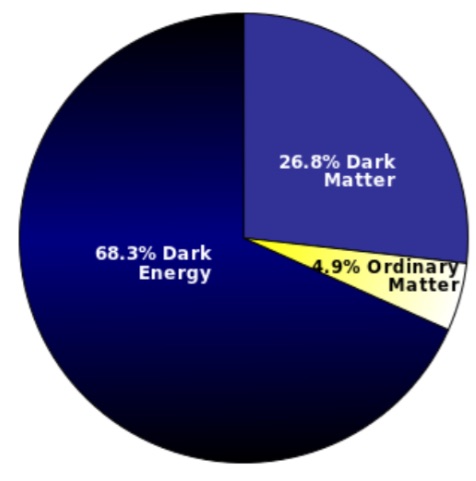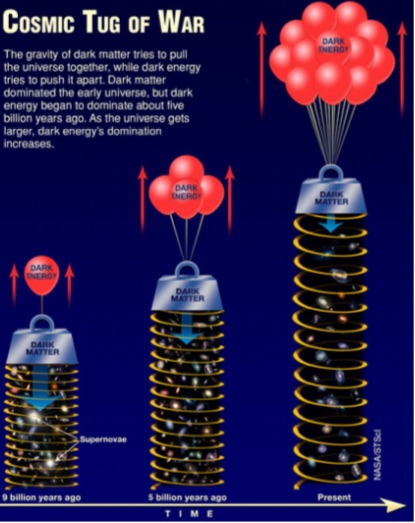
Cosmology and our View of the World
What are Dark Matter and Dark Energy? Do they exist?
Lead: Jonathan Bower
3/10/2015
Summary by Greg Hilston
What are Dark Matter and Dark Energy?
Reading: Philosophy and Science for Everyone, Ch. 3
Our weekly reading opens up with discussing the current cosmological model, also known as the “concordance model”, which builds on Einstein's’ general-relativity (gr). What’s interesting about the concordance model is that it suggests that our universe is built up of approximately 70% dark energy, 25% dark matter and 5% ordinary matter. Throughout the presentation, Jonathan guided the class in learning what dark energy and dark matter are proposed to be and led the discussions on current theories and beliefs on their discovery process.
Jonathan opened up the presentation with a pie chart depicting the amount of dark energy, dark matter, and ordinary matter in the universe, as described by the concordance model. This chart shows that most of the universe is thought to be made of things we cannot see, but can observe their effects on ordinary observable matter. The group asked why the pie chart did not have a place to represent the energy equivalent of ordinary matter and also the energy of light. These questions were quickly answered with ordinary matter and energy being equivalent and interchangeable, based on Einstein’s mass–energy equivalence concept (E = MC^2 ) and that the energy of light is too negligible a contribution to be accurately shown in the chart. An interesting thought was brought up, saying that we’ve worked with just the ordinary matter in physics, for hundreds of years, developing all our theories with just 5% of the universe’s makeup. With respect to dark matter, potential candidate particles have been predicted, but none have been detected unambiguously thus far.
With the pie chart still up for discussion, another question was brought up, asking where did the kinetic energy of all of particles and subatomic particles fall into the chart. The motion of the particles and subatomic particles are part of the mass. The mass accounts for the motion of the atoms, the vibrational, translational, and rotational movements experienced, which are again part of the massenergy equation. With the discussion now on the massenergy equation, the thought of dark energy and dark matter not following its conventions was brought up. Dr. Möbius informed the class that dark energy abides by the equation by definition to sum up the universe mass to the critical value, but it hasn’t been observed yet. In fact, the percentages given in the chart are based on the definitions of dark matter and dark energy and the assumptions that scientists have made. It might seem odd to be searching for a type of matter we cannot physically see, but there are many observations we can make that point to dark matter (e.g. galaxy rotation) and energy (e.g. accelerating expansion of the universe).
In regards to dark matter and the lack of direct observations, the reading brought up the interesting topic of the discovery of the planet Neptune in 1846. The anomalous orbit of the planet Uranus was well known at the time and was studied independently by two astronomers, both of which proposed a new planet, Neptune, that interfered with the known planet Uranus. Neptune’s position was mathematically calculated and predicted, later to be confirmed through observation. An example like the discovery of the planet Neptune may very well be the same story for our future observation of dark matter, where theoretical ideas and predictions are made and later hard evidence is observed.
Above is a picture illustrating the Milky Way and the bubble is the only area in which we have actively searched for dark matter. Although the area is small, it is believed that we would have encountered dark matter even with such a small search area, primarily due to its believed abundance in our universe. Searching is done by observing stars and their planets and looking for any changes in their orbit, which would suggest the presence of dark matter, much like the concepts used to discover the planet Neptune.
When discussing WIMPs, weakly interacting massive particles, a class member brought up the predictable consequences they experience and how we should be able to observe them but haven’t yet. We then discussed the weak force and neutrinos, which prompted Dr. Möbius to remind the class that the weak force is not like neutrino detection, mentioning that only the great difficulty that was experienced when trying to observe neutrinos is similar. To put into perspective, for WIMPs the cross sections are even smaller and much more difficult to detect. In many scientific fields, observations are only to be recorded if the standard deviation is outside fivesigma. At this rate, there is only one chance in nearly two million that a random fluctuation would yield the result ("CERN experiments observe particle consistent with longsought Higgs boson,| CERN press office". Press.web.cern.ch. 20120704. Retrieved 20130810). This concept is important, as it ensures that “noise” or other false outliers do not influence the data. It also ensures scientists are able to take steps to minimize impurities in their claims.
We then discussed that the consensus is that dark energy is driving the universe's’ accelerating expansion. If one has a sphere of X matter that expands by a factor of 2, it then has 1/8th the matter density now. With dark energy, the density stays constant. Dr. deVries pointed out that since space expands and the energy density remained constant, there must effectively be more energy there, forcing the density to remain constant. This concept of more energy being present is due to the fact that dark energy is a property of space and would be observed as space expanded. We spoke as a class about the critical density and how it represents the density at which the universe is flat and Dr. Möbius added that it also has to do with the expansion rate balanced by gravity, ensuring that it will not fall back on itself, but rather will continue to expand at a finite rate and only slow down asymptotically.
Jonathan asked if the amount of dark matter in the universe is constant. Dr. Möbius replied that it is constant, just like ordinary matter. The amount of dark and regular matter emerged at some point and time and is constant for the entire universe. On the other hand, the total amount of all forms of matter in our observable universe is decreasing, as things are going past the horizon. As time progresses, our observable universe will become a pretty lonely place.
Above is an interesting graphical representation that Jonathan used when discussing the phenomenon of dark energy overpowering dark matter over time. In the beginning of the universe, dark matter’s gravity was able to keep the universe together while dark energy tried to pull it apart. As time progressed, the universe expanded, allowing dark energy to dominate dark matter. With the similar naming conventions, the catchphrase of the night was easily “Not dark matter, but dark energy”, as many speakers were easily confusing the names during conversations.